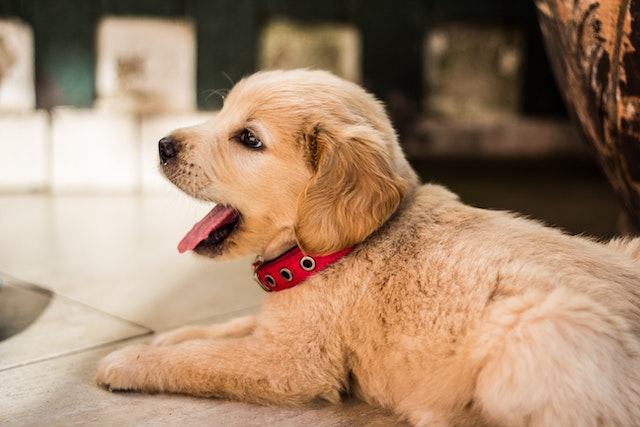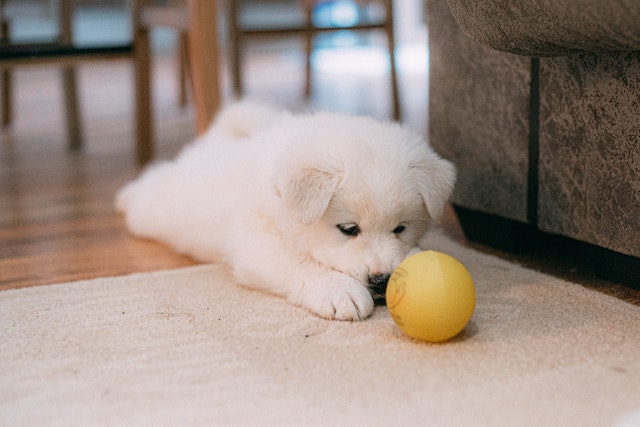

Welcoming a New Puppy: The First Day at Home
When it comes to dog ownership, first impressions go a long way. Carefully preparing to welcome a puppy home and taking the right steps once they’ve arrived can help promote good habits and build a strong, long-lasting bond.

Writer Animalia Team
7 min read

When it comes to dog ownership, first impressions go a long way. Carefully preparing to welcome a puppy home and taking the right steps once they’ve arrived can help promote good habits and build a strong, long-lasting bond.
Before your puppy arrives
Responsible pet ownership begins before your puppy even arrives. Purchasing pet insurance provides peace of mind from Day 1, helping ensure you can always pay for care. An introductory vet visit is just as important. Your vet will serve as a pet care ally throughout your dog’s life and
Make sure to stock up on all the essentials as well. In addition to food and treats, you’ll want to make a trip to the pet store for ID tags, cleaning supplies, a leash, and plenty of toys. Talk to your veterinarian about pet care necessities to ensure you don’t leave anything off your shopping list.
Introducing your puppy to their new home
Coming to a new home can be a stressful experience. Think about it – all the familiar sights, sounds, and smells of your puppy’s young life are being replaced with new ones. To help your puppy settle in, follow our tips:
- Designate some personal space: Introduce your new arrival to their new personal puppy zone. This is where a puppy’s bed , bowls , and toys should reside. They’ll sniff and explore the scents and sights of this area and, once they’re relaxed, gradually begin to explore more. Tempting as it might be, don’t overwhelm new arrivals with cuddles and play out of the gate. Wait until they’re calm, comfortable, and confident before you start doling out the attention.
- The potty spot: You and your puppy will get along much better if accidents are kept to a minimum. Designate a ‘potty spot’ outdoors or near their personal space. Bring them here, use clear vocal cues, and offer positive reinforcement once they’ve gone to the bathroom.
- Meeting the family: If you’re welcoming a puppy to a crowded house, try to introduce family members one at a time. Make sure each interaction is calm and that your puppy shows no signs of serious discomfort. Supervise children especially carefully, discouraging rough play and tight hugs.
- Introducing other pets: Exercise similar care in introducing your new dog to other pets. Give them space to interact with one another, but be ready to intervene if things take a turn for the combative or if either pet appears agitated.
- Keep excitement to a minimum: Don’t invite neighbors or extended family to greet your new puppy on their first day home. Instead, keep the homecoming as low-key as possible with quiet voices and gentle handling.
- Plan for quality puppy time: To begin bonding with your puppy and training them, it’s important that you spend as much quality time with them as possible. If possible, bring your puppy home in the morning so they have plenty of time to play and settle in before bedtime and plan to spend a few days at home.
- Setting ground rules: Puppies are full of energy and their playfulness can often get the better of them . Discourage destructive and annoying habits from the start by firmly and calmly enforcing guidelines. Establishing these rules will provide the foundation of a strong, respectful relationship. Make sure to offer plenty of praise when your puppy behaves appropriately.

Establishing a daily routine
The key to successful dog training is consistency. Your puppy may grow confused if they are allowed on the bed by one person and not by another. Here are a few training tips to follow until your new arrival is old enough for classes with a professional.
- Establish mealtime routines: A growing puppy needs plenty of food and serving meals at the same time every day is an easy way to help them grow accustomed to routine.
- Potty training: Offer plenty of opportunities throughout the day for your puppy to relieve themselves. When accidents do happen (you’ll probably have at least a few) take care not to use negative reinforcement. Punishment can make a tough situation tougher, encouraging pups to feel anxious. Offer plenty of positive reinforcement instead. Playtime: Play is a great way of exercising and bonding with new puppies. You’ll have fun together and they’ll have an outlet for all their energy.
Getting through the first night at home
Establishing a good bedtime routine is a vital part of dog training. Some puppies settle down right away and sleep through the night while others are more demanding come bed time. Crate training is often helpful for establishing a dependable bedtime routine. By making the crate comfy with a bed and blankets, you can make the crate an appealing place to sleep. Before they head to bed, make sure your puppy has gotten plenty of exercise and a chance to relieve themselves. You might experience a few nights of restlessness, but good habits and a clear routine will soon have puppies sleeping soundly.
Puppy proofing your home
Puppies have sharp, little teeth! They’ll chew on anything and everything they can sink their teeth into, especially when they’re shedding their primary teeth. This can be dangerous for puppies and destructive to your home. Wires such as phone chargers, computer cables, and headphones are particular favorites. Puppy proof your home ahead of time by placing wires and other chewable, potentially dangerous objects out of reach.. Proof your home further by locking away medicines and cleaning products as well foods like chocolate and grapes that can be fatal to puppies. Outdoors, make sure there are no escape routes such as holes in fences or places where an adventurous puppy might dig their way to freedom. Do some research before your puppy arrives so they can safely enjoy playing outside. Read up, for example, on potentially toxic plants your pup might consume.
Choosing the best vet for your puppy
One of the best ways to find a vet is through a personal recommendation from a pet-owning friend. Make sure whoever you choose is registered with the American College of Veterinary Surgeons and has plenty of experience treating dogs. Finding a vet who’s close to home can make a difference in the event of a serious pet health emergency. During your initial visit, take note of cleanliness and customer service to make sure you’ve made the right decision. If you or your pet feels uncomfortable, find a new vet.
The value of pet insurance
Vet bills can quickly escalate so having pet insurance is vital. Conduct thorough research on your options beforehand, assessing coverage details and costs carefully. A good policy will cover a range of treatments related to accidents and illnesses. More expansive policies may cover fees related to congenital conditions, preventive treatment, and more. Pet insurance is one essential most pet owners still forget. Though your pet can’t say thanks for purchasing a policy, you’ll be glad you did.





We offer the most
comprehensive coverage
out there
car with a spare tire for life’s bumps.
Having Animalia is like a pimped-out
Rolls Royce with a swimming pool
in the trunk.



Get your pet insurance quote
Pet type
- Dog
- Cat




